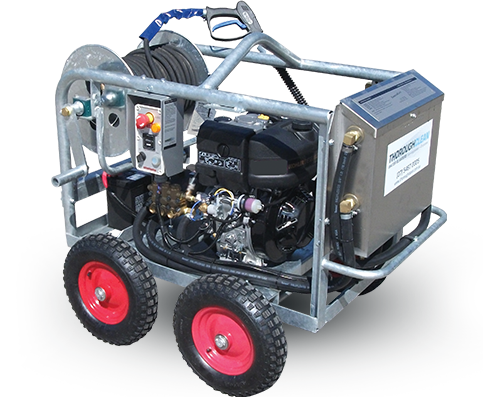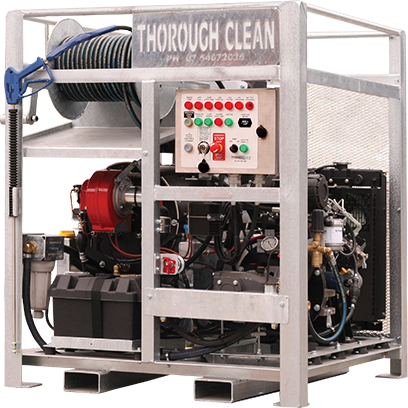It is important to select the correct pressure cleaner nozzle for the job because incorrect selection may either damage the surface you are cleaning, or increase cleaning time and efficiency significantly.
Nozzles (or jets) are available in different angles AND different sizes: Angle is important for the correct job, and the size has to match up with the pressure and flow of your specific pressure cleaner. We usually look up the size on a Pressure-Flow chart to ensure efficient operation and cleaning. An example of a nozzle’s numbering is ‘15060’ The first two digits denotes the angle (15 degrees in this case) and the ‘060’ is the nozzle size.
There are two main types High Pressure Cleaner Nozzles:
A. – Static Nozzles (with different degree angles – 0, 15 or 25 degrees usually)
B. – Rotary nozzles (Essentially a 0 degree nozzle with a high speed spinning motion)
There are also Low Pressure Nozzles used for the application of detergents to surfaces before cleaning with High Pressure Water. (C. below)
A. HIGH PRESSURE STATIC NOZZLES:
0º Pencil Jet/Nozzle:
Operates at 0 Degree pencil point pattern, best suited for spot cleaning. Ideal for stains on concrete, caked on grime, even dirt in cracks. This nozzle is super powerful and is best kept away from delicate surfaces. This is also the most dangerous nozzle to work with and can slice through a finger or foot or worse. Always wear the correct protective gear with steel-cap boots, long heavy duty trousers, eye protection and even gloves for all high pressure cleaning operations.
15º Narrow Fan Nozzle:
The most popular nozzle for general HP cleaning jobs on hard surfaces. Operating at a 15 degree fan pattern, this fan operates similar to a chisel. When held at a 45 degree angle, it can be used as a scraper to remove peeling paint or varnish, or mildew. It is also useful to help undo the bond for difficult tasks. Always test on an inconspicuous area first to ensure that it does not damage surfaces.
25º Fan Flushing Nozzle:
Operating at a 25 degree fan pattern, this washing nozzle cleans grease, grime and algae easily on brick walls and roofs and other surfaces. It can be used to sweep leaves, clean driveways, pavements or most flat surfaces. The fan pattern allows for good pressure and cleaning coverage.
40º Fan Soft Wash Nozzle:
Operating at a 40 degree fan pattern, it is best suited for washing/ rinsing glass or motor vehicles or even to give your driveway or tiled area a quick hose down. These tips are also great for washing wooden decks, mouldy shade cloth and delicate surfaces.
B. HIGH PRESSURE ROTARY NOZZLES (Turbo Nozzles / Roto Jets):
These nozzles operates in a rotary fashion, by releasing the water in a fast-spinning circular motion. This nozzle is ideal for hosing pathways, driveways and other concrete surfaces, cutting your cleaning time at least in half whilst providing maximum cleaning effect.
Turbo Nozzles must also be sized according to the pressure and flow of your machine. They can be expensive, but well worth the money. The internal components of a Turbo Nozzle is made of ceramic which can crack or break when a nozzle is dropped, hit against a hard surface or even when pointed upwards when the trigger is pulled – forcing the loose spinning ceramic part at high speed against the front surface of the nozzle. Always point a turbo nozzle downwards when starting pressure cleaning operations, then move upwards.
C. LOW PRESSURE NOZZLES:
Low pressure cleaner nozzles are used for detergent application. This nozzle is used with downstream chemical injectors. Downstream means that the water and chemicals are combined after the solution leaves the pump, to prevent any damages to the pump unit. This nozzle creates a siphoning action (Venturi Effect) to introduce the chemicals to the water flow. Chemical is reduced in concentration by about 90%.
A more efficient way is often to use a low pressure spray pack – applying detergent neatly to oily surfaces (after caked on grease and grime was first removed with high pressure water) and leaving it to soak in and change the chemical bond for about 5 minutes, then rinse off with a water blaster.
In Summary
Always size your nozzle by an expert! Choose the right pressure cleaner nozzle for the job. Always test first to ensure you are not damaging the cleaning surface. Always wear protective gear when working with high pressure water cleaner equipment.









